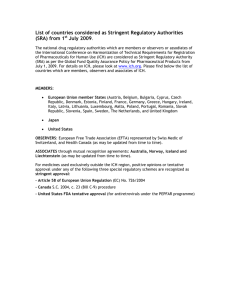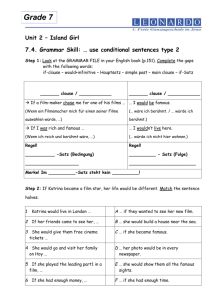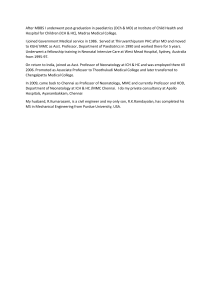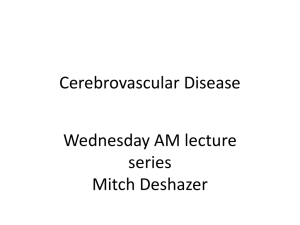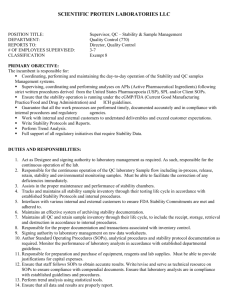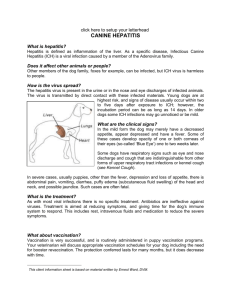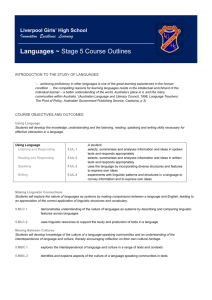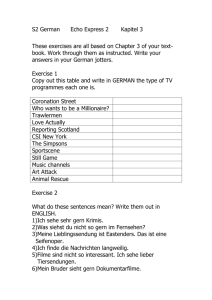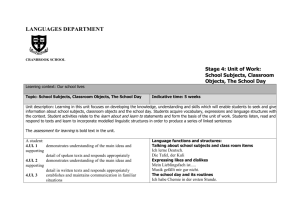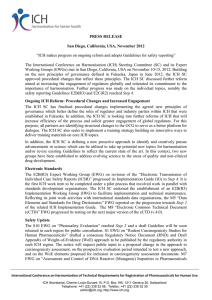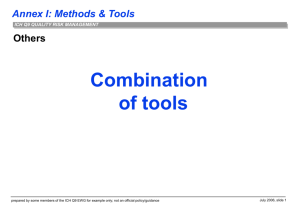Eating and drinkingUOW 1
advertisement
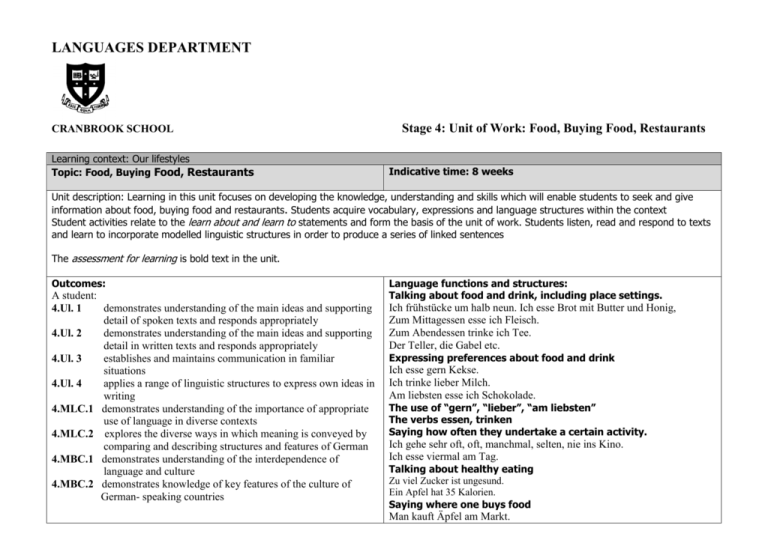
LANGUAGES DEPARTMENT CRANBROOK SCHOOL Learning context: Our lifestyles Topic: Food, Buying Food, Restaurants Stage 4: Unit of Work: Food, Buying Food, Restaurants Indicative time: 8 weeks Unit description: Learning in this unit focuses on developing the knowledge, understanding and skills which will enable students to seek and give information about food, buying food and restaurants. Students acquire vocabulary, expressions and language structures within the context Student activities relate to the learn about and learn to statements and form the basis of the unit of work. Students listen, read and respond to texts and learn to incorporate modelled linguistic structures in order to produce a series of linked sentences The assessment for learning is bold text in the unit. Outcomes: A student: 4.Ul. 1 demonstrates understanding of the main ideas and supporting detail of spoken texts and responds appropriately 4.Ul. 2 demonstrates understanding of the main ideas and supporting detail in written texts and responds appropriately 4.Ul. 3 establishes and maintains communication in familiar situations 4.Ul. 4 applies a range of linguistic structures to express own ideas in writing 4.MLC.1 demonstrates understanding of the importance of appropriate use of language in diverse contexts 4.MLC.2 explores the diverse ways in which meaning is conveyed by comparing and describing structures and features of German 4.MBC.1 demonstrates understanding of the interdependence of language and culture 4.MBC.2 demonstrates knowledge of key features of the culture of German- speaking countries Language functions and structures: Talking about food and drink, including place settings. Ich frühstücke um halb neun. Ich esse Brot mit Butter und Honig, Zum Mittagessen esse ich Fleisch. Zum Abendessen trinke ich Tee. Der Teller, die Gabel etc. Expressing preferences about food and drink Ich esse gern Kekse. Ich trinke lieber Milch. Am liebsten esse ich Schokolade. The use of “gern”, “lieber”, “am liebsten” The verbs essen, trinken Saying how often they undertake a certain activity. Ich gehe sehr oft, oft, manchmal, selten, nie ins Kino. Ich esse viermal am Tag. Talking about healthy eating Zu viel Zucker ist ungesund. Ein Apfel hat 35 Kalorien. Saying where one buys food Man kauft Äpfel am Markt. Ich gehe in den Supermarkt. Man kauft Kuchen in der Konditorei The indefinite pronoun “man”. The preposition “in” + accusative and dative case (with shops) The preposition “an” + dative Talking about weights, quantities and containers Hundert Gramm Wurst. Ein Glas Honig. Ordering food in a pizzeria, ice cream stall and sausage stall Sabine bestellt Pizza mit Tomaten und Schinken. Ich möchte einen Hamburger, einen Apfelsaft und ein Eis. Einmal Erdbeer, bitte. The use of einmal etc. The use of ich möchte CONTENT Students learn about: the purpose and context of communication and their influence on the choice of structure, format and vocabulary verbal and nonverbal links with a conversational partner the importance of understanding the intention of speaker/s and the context interpreting the meaning linguistic features of texts, such as conversations, ACTIVITIES AND RESOURCES ASSESSMENT Teacher’s oral presentation to Flashcards students of breakfast food and drink EVIDENCE OF LEARNING AND FEEDBACK Oral responses and level of participation will demonstrate students’ understanding of what they have heard / Teacher’s oral feedback on pronunciation interviews and messages. ways to analyse and locate relevant information in text the purpose of communication and their influence on the choice of structures, format and vocabulary accessing resources and the organization of relevant structures and vocabulary when planning and constructing text appropriate choices made to achieve communication goals specific patterns and rules in word construction, word order and sentence structure the significance of cultural awareness in language use and the influence of cultural values on how meaning is conveyed the importance of tradition to a sense of cultural identity and diversity within the culture ways in which language and behaviour reflect important aspects of culture Students learn to: Initiate an interaction, eg by greeting, asking questions Maintain social interactions and communicate appropriately in familiar contexts, eg. turn-talking, Students listen to people at breakfast in Germany and say what different people have to eat and drink for breakfast, matching them with drawings of food and drinks Zickzack 1 p 56 Lernpunkt Deutsch 1 p 92 Correct matching of items will demonstrate students’ understanding of what they have heard / Teacher’s oral feedback on correct identification of detail agreeing, acknowledging and replying identify roles and relationships between participants in the text identify specific information, eg by answering questions in English or German, choosing the correct word. linguistic features of texts, such as descriptions, narratives and correspondence. plan, draft and edit when constructing own text use available resources to build a message recognise linguistic choices made according to purpose, eg request identify specific characteristics of the language, eg grammatical structures and features recognise that there are culturally appropriate expressions for particular contexts identify aspects of language that encapsulates aspects of culture Students read a survey about breakfast habits and complete gapped sentences Zickzack 1 p 57 Oral and written responses identifying detail of the survey / Teacher’s oral feedback Pair work: Students draw a breakfast menu, label it and compare it to their partners’ choices Pairwork: Students talk about what food and drink they have for recess Lernpunkt Deutsch 1 p 93 Drawing and labelling appropriate items and making comparisons / Teacher’s oral feedback Performance of the role play will demonstrate students’ ability to establish and maintain Katzensprung 1 p 72 Presentation of food eaten at lunch and dinner. Students listen to the words and repeat them Flashcards Students listen to people talk about their lunch and dinner Zickzack 1p 58 Lernpunkt Deutsch 1 p 94-95 Reading: Comments from teenagers on healthy eating Zickzack 1p 60 Students read a calorie chart and work out how many calories are contained in illustrated meals and snacks Students listen & resdond to young people talk about what they like eating, prefer and like most of all Zickzack 1 p 60 Interactive web exercises http://gut.languagekills.co.uk/Year 7.html - Food Written consolidation exercises Lernpunkt Deutsch 1 Australian Workbook chapter 9 p. 6, 8 Zickzack 1 Arbeitsbuch p.60,61,67 167 GM’s Arbeitsbuch 5&7 p 10,12,16,17 Selbstbedienung Zickzack 1 chapt 6 Writing task: Write an email Lernpunkt Deutsch 1 p 98 communication / Teacher’s oral feedback on the content and performance of the role play Oral responses and level of participation will demonstrate students’ understanding of what they have heard / Teacher’s oral feedback on pronunciation Oral responses and level of participation will demonstrate students’ understanding of what they have heard / Teacher’s oral feedback Oral responses identifying the main ideas and specific detail of the text / Teacher’s oral feedback Oral responses working out the number of calories/ Teacher’s oral feedback Oral responses and level of participation will demonstrate students’ understanding of what they have heard and are able to say / Teacher’s oral feedback Active learning from interactive exercises / Teacher observation and self assessment with the help of the internet Correct completion of exercises / Teacher’s written feedback Appropriate use of structure, format from Germany comparing German and Australian eating and drinking habits. Also mention what your preferences are and what you consider as being healthy. Presentation of shops. Students listen to the words and repeat them. and vocabulary in the letter / Teacher’s written feedback on structure, format and vocabulary Flashcards Zickzack 2 p 30 Students listen to what is sold in different shops Zickzack 2 p 26 Presentation of food quantities and containers Flashcards Zickzack 2 p 31 Students listen to what customers by in a shop and match the items to pictures Pair work: Students study a price list of drink and food and decide how they would like to spend their money for a picnic. Each group then presents their purchases to the class Reading & writing: Students going shopping for a birthday party Students listen to a family ordering food in a pizzeria, at an ice-cream stall and a sausage stall Zickzack 2 p 31 Reading: Students decide from Zickzack 1 p 89 Zickzack 2 Copymasters 17, 18 Katzensprung 1 p 75-77 Katzensprung 1 Workbook p 76 Zickzack 1 p 59, 88 Oral responses and level of participation will demonstrate students’ understanding of what they have heard / Teacher’s oral feedback Oral responses and level of participation will demonstrate students’ understanding of what they have heard / Teacher’s oral feedback Oral responses and level of participation will demonstrate students’ understanding of what they have heard / Teacher’s oral feedback on pronunciation Correct matching of items / Teacher’s oral feedback Oral presentation of shopping list Correct completion of exercises / Peer assessment & Teacher’s oral and written feedback Oral responses and level of participation will demonstrate students’ understanding of what they have heard / Teacher’s oral feedback Oral responses identifying the main visuals if the waitress has brought the correct order Pair work: Students create dialogues, one student being the customer and the other the sales assistant Lernpunkt Deutsch 1 p 97 Oral presentation: Students present their dialogues to the class Written consolidation exercises Listening and reading tasks: Students identify detail of texts about food and restaurants ideas and specific detail of the text / Teacher’s oral feedback Performance of the role play will demonstrate students’ ability to establish and maintain communication / Teacher’s oral feedback on the content and performance of the role play Performance of the role play will demonstrate students’ ability to establish and maintain communication / Teacher’s oral feedback on the content and performance of the role play Correct completion of exercises / Teacher’s written feedback Zickzack 1 Arbeitsbuch p.107 GM’s Arbeitsbuch 8&9 p 21,22 Selbstbedienung Zickzack 1 chapt 9 Teacher produced material Written responses will demonstrate students’ understanding of what they have heard and read / Teacher’s written feedback on correct identification of detail and general aspects of the text This document has been produced by the Languages Staff at Cranbrook School with funds provided by the Australian Government through the School Languages Program.
